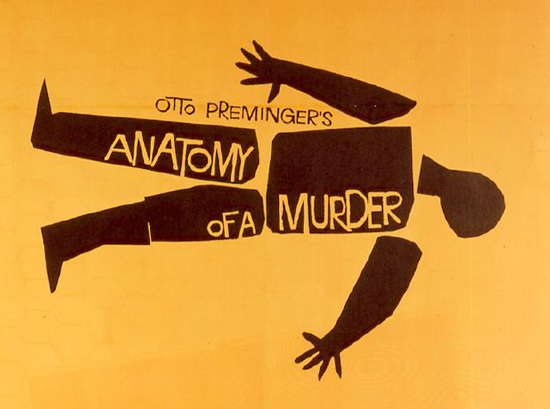
Saul Bass designed the title sequence for Otto Preminger's Anatomy of a Murder, one of this year's Registry selections.
The Library of Congress announced the addition of 25 more movies to the National Film Registry, bringing the total up to 600 titles. This year’s additions include home movies, actualities, documentaries, industrials, a fight film, and experimental titles along with the usual mix of Hollywood features old and new.
New to the Registry: itinerant filmmaker Melton Barker, who enlisted local children into shorts that have been collected under the umbrella The Kidnappers Foil; Bob Clark, who wrote and directed the holiday perennial A Christmas Story based on Jean Shepherd’s reminiscences; Delmer Daves, who directed the Elmore Leonard-based 3:10 to Yuma; and Penny Marshall, the former television star who directed A League of Their Own.
Returnees to the Registry include Don Siegel (Invasion of the Body Snatchers), now also represented by Dirty Harry, a turning point in cop films. Director Maurice Tourneur, whose The Poor Little Rich Girl (1917), The Blue Bird (1918), and The Last of the Mohicans (1920) were already in the Registry, now has The Wishing Ring; An Idyll of Old England (1914), his American feature debut. (Tourneur’s son Jacques also has a Registry title: 1942’s Cat People.) Born Yesterday adds to other George Cukor movies like The Women (1939), The Philadelphia Story (1940), Adam’s Rib (1949), and A Star Is Born (1954).
This year the Registry honors NFL Films, a hugely significant company that helped change the image of the sport and how it was documented. Founded by Ed Sabol in 1962, the company was run by his son Steve Sabol, who passed away this September from brain cancer.
The Middleton Family at the New York World’s Fair (1939) marks the second industrial film about Westinghouse on the Registry. (The first, Westinghouse Works, made by Biograph in 1904, documented a Westinghouse factory near Pittsburgh.) Kodachrome Color Motion Picture Tests (1922) marks an effort by Kodak to offer a commercial alternative to Technicolor. Kodachrome was the trade name for one of the most popular still photography color formats, and although Kodachrome was used in motion pictures Technicolor dominated the industry for decades.
Registry selections often honor filmmakers who were working well in the past. But Richard Linklater, whose Slacker (1991) was selected, is known for such recent movies as School of Rock (2003) and Bernie (2011), both starring Jack Black. Linklater’s next film, Before Midnight, completes a trilogy of romances starring Ethan Hawke and Julie Delpy.
Perhaps the most well-known movie on this year’s list is The Matrix (1999), the first in a science-fiction trilogy starring Keanu Reeves. It was directed by Andy and Larry (now Lana) Wachowski, who this year collaborated with German director Tom Tykwer on Cloud Atlas.
Most of this year’s titles are readily available for viewing. In future postings I’ll go describe some of the more obscure selections in greater detail. And eventually the selections from this year and from 2011 will appear in the third volume of my series America’s Film Legacy.



Daniel,
I teach Native American Film at UCLA and authored the book, Making the White Man’s Indian (2005).
I recently noticed your entry for White Fawn’s Devotion and its director, James Young Deer. He does not appear on the Winnebago tribal rolls and two tribal historians have said Young Deer was never a member of the Winnebago tribe. Young Deer comes from Washington, DC and his background is a mixture of mulatto and possibly Indian, although from a tribe that is not federally recognized. The info on him through the LOC was incorrect (I suggested they drop the Winnebago affiliation) although one may argue that he could have a Native American background. His case is very problematic–unlike Iron Eyes Cody who was Italian with no Indian heritage (I broke that story for the Times-Picayune in 1996). Young Deer grew up in Washington, entered the military, and adopted the Winnebago name after he married Lillian (who was Winnabago) in 1906. When the couple separated in 1915, he dropped the Winnabago affiliation and thereafter was referred to as “and Indian actor” or director. When he died, the military identified him as African American.
Hope this helps.